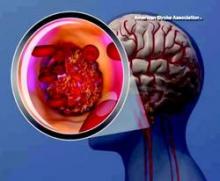Treatment of ischemic stroke patients who developed a symptomatic intracerebral hemorrhage after receiving recombinant tissue plasminogen activator did not significantly reduce risk of death in the hospital or expansion of hematomas.
However, the study also found that times to diagnosis of symptomatic intracerebral hemorrhage (sICH) were long, and reducing these could be a potential factor in treatment success.
Dr. Shadi Yaghi of Brown University, Providence, R.I., and colleagues evaluated records from 128 patients from 10 U.S. stroke centers who developed sICH after being treated with recombinant tissue plasminogen activator (3.3% of 3,894 rTPA-treated patients). Their report was published online Oct. 26 in JAMA Neurology (doi: 10.1001/jamaneurol.2015.2371).
Overall, sICH diagnosis was made more than 2 hours after initiation of intravenous rTPA therapy in 85.9% (110 of 128) of patients. A total of 38% (n = 49) received treatment for sICH, with 29% (n = 37) assigned to palliative care within 24 hours of diagnosis. More than half of patients (n = 67) died in hospital.
Assignment to palliative care was the only factor seen significantly associated with in-hospital-mortality (odds ratio, 3.6; 95% confidence interval. 1.2-10.6). Treatments for sICH varied, though the most commonly used were cryoprecipitate (31.3%), platelet transfusion, and fresh frozen plasma. Median time from initiation of rTPA to sICH diagnosis was 470 minutes (range, 30-2,572 minutes), and median time from diagnosis to treatment of sICH was 112 minutes (range, 12-628 minutes).
Dr. Yaghi and colleagues’ study did not find statistically significant differences in effectiveness among treatments. However, they found that fibrinogen levels below 150 mg/dL were significantly associated with a hematoma expansion of 33% or more among patients who had imaging studies available for analysis. Low fibrinogen occurred in 36% of patients without hematoma expansion, compared with 25% of patients with expansion (P = .01). This suggests that cryoprecipitate, which increases fibrinogen levels, might help in reversing coagulopathy caused by rTPA, particularly if it is administered early, the authors said. “It may be reasonable to initiate empirical treatment with cryoprecipitate once sICH is diagnosed, before obtaining fibrinogen levels, and additional cryoprecipitate treatment can be given as needed once the fibrinogen level is known,” they wrote.
The researchers acknowledged that the limitations of their study included its retrospective design, relatively few sICH patients treated, and wide variety of treatments used.
Dr. Yaghi reported funding from the Stroke Trials Network of the National Institute of Neurological Disorders and Stroke. Two coauthors disclosed consultant relationships with Stryker, Covidien, and HeartWare.


